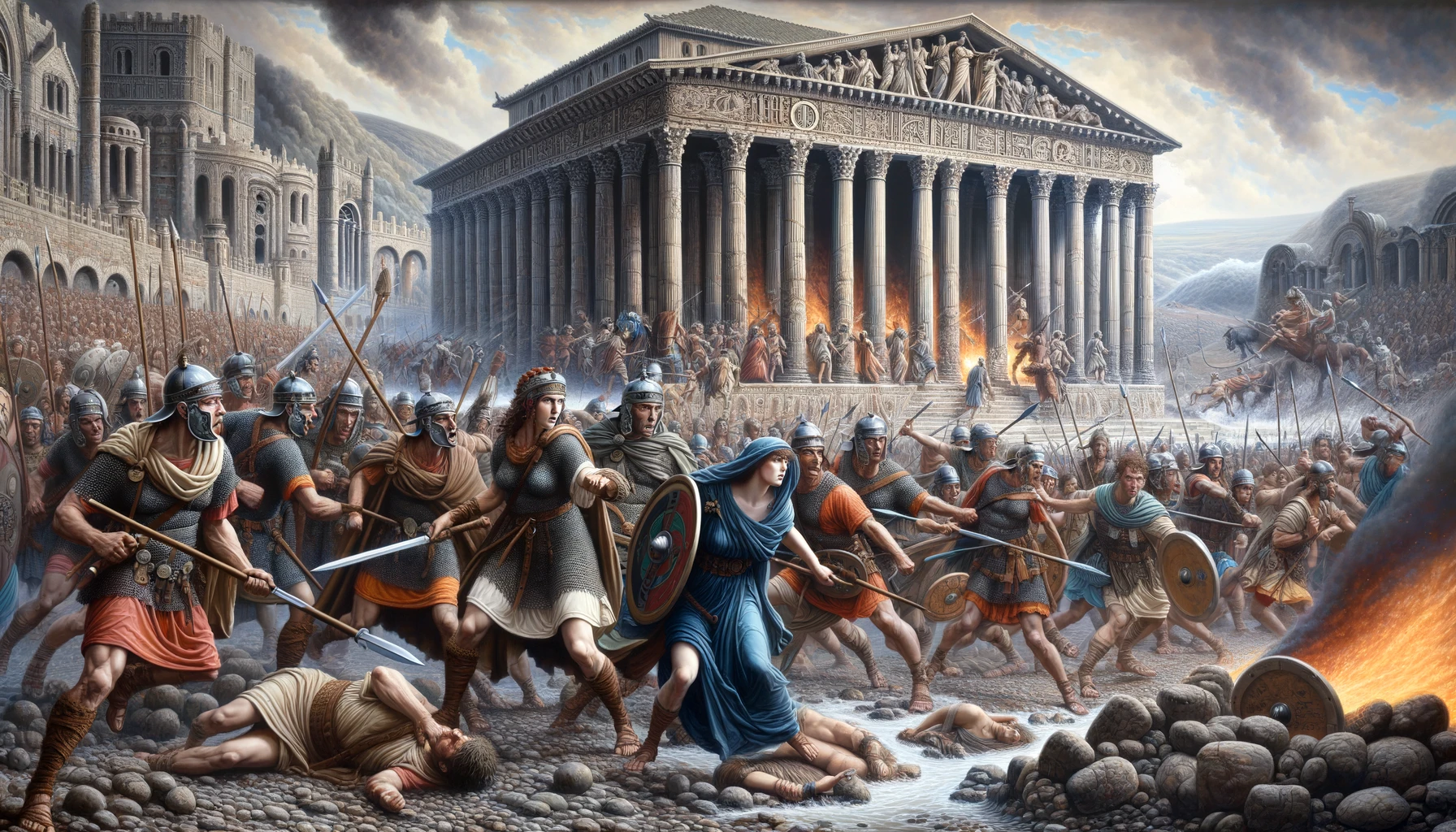The Growth of Colchester (Camulodunum)
Roman colonies were common throughout the Roman Empire. They often had a standard form with a grid system of paved roads and a focal forum and basilica complex that was the centre of local government by the local senate, or governing body, of the colony. A colony was a self-governing
group of Roman citizens, effectively an extension of the city of Rome itself.
The colony was established when the pre-existing legionary fortress was abandoned and many of its buildings and streets were reused in the early phases of its development. Many of the military buildings were adapted for civilian use, providing houses for the settlers. It has been suggested that the defensive ditches of the fortress were filled in because the area it contained was not large enough for the laying out of the public buildings and houses of the colony.
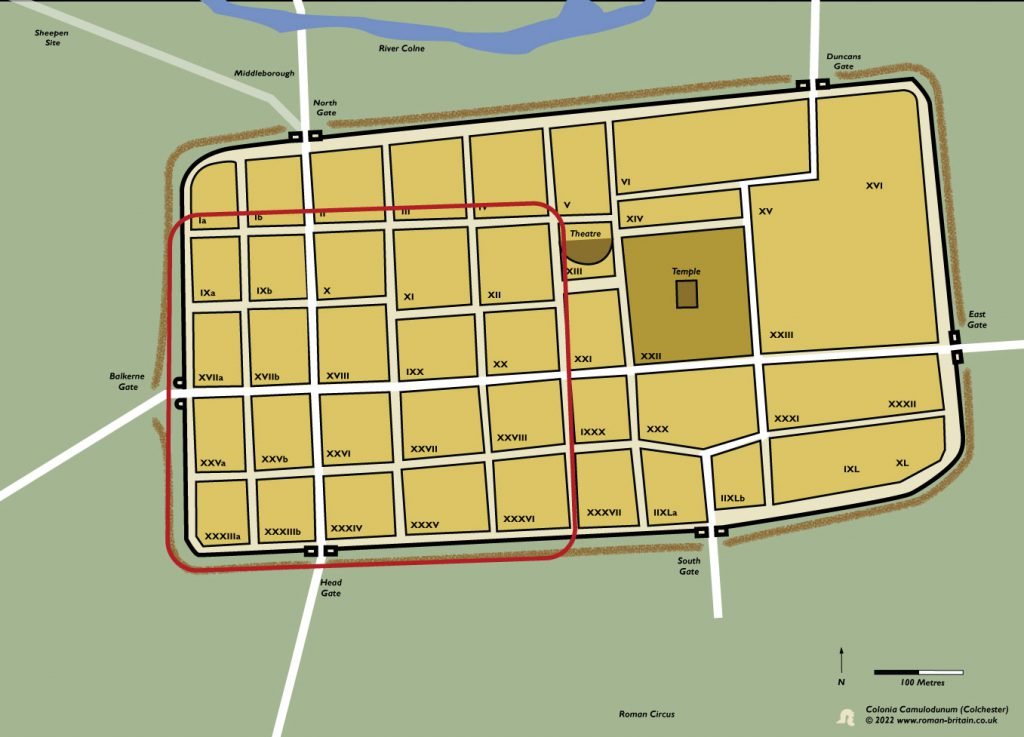
The headquarters building of the fortress may have acted as the new forum and basilica. The area beyond the fortress to the east, which had formed an annex, was given over, at least in part, to public buildings, including the temple of Claudius and perhaps the theatre. The temple of Claudius indicates that Camulodunum operated as the centre of imperial worship before the revolt. It is possible, for various reasons, that the building of the temple began prior to the death of Claudius in AD 54.34 It was a monumental building, the podium of which survives today in the vaults of Colchester Castle. Most colonies also possessed a theatre, where plays and religious ceremonies were performed. The site of the theatre has been located close to the temple of Claudius; it may have played a role in the way that the cult of the emperor functioned. In addition to the veteran soldiers, the colony would have attracted tradesmen and merchants. Some may have travelled to the province to exploit new economic opportunities but others must have come from the native population of Britain.
In AD 60 to 61, this colony was a prosperous and developing town of cosmopolitan inhabitants. The population of the town and surrounding territory may have numbered only around 4000 people, possibly more.
The Attack on Colchester (Camulodunum)
The first target of the Iceni and their Trinovantian allies was Colchester (Camulodunum). Their attack came in the late spring, with the campaigning season already underway.
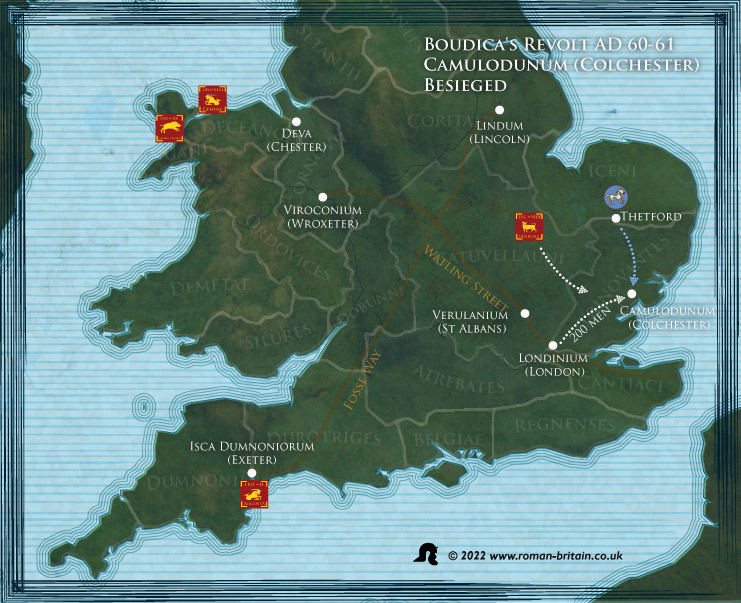
When the townsfolk got wind of impending rouble they appealed to Catus Decianus to reinforce the few troops still based there, but the procurator was able to spare only two hundred inadequately armed men. Preparations for the defence of the town were hindered by secret supporters of the rebel cause.
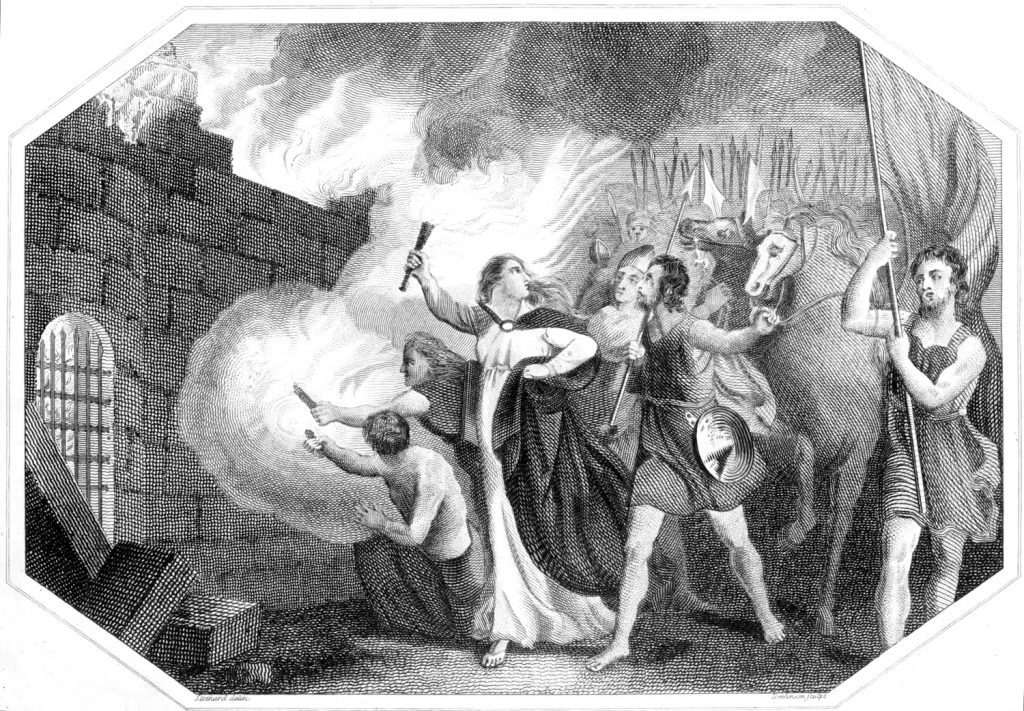
But as Suetonius was far away, they implored aid from the procurator, Catus Decianus. All he did was to send two hundred men, and no more, without regular arms, and there was in the place but a small military force.
Tacitus: Annals: Book Fourteen: XXXII Camulodunum (Colchester) destroyed
No attempt was made to erect any defences, nor were women and the elderly evacuated. Tacitus says the town was not defended by a rampart and ditch; archaeology confirms, this because the rampart of the former legionary fortress had been demolished and shovelled into its ditch c.AD 55. Q.
[T]hey had constructed neither fosse nor rampart; nor had they removed their old men and women, leaving their youth alone to face the foe.
Petillius Cerialis, the courageous but impetuous commander of the Legio Nonae Hispana (The Ninth Spanish Legion), marched south to the rescue of the town from his base in the east Midlands with a detachment of his legion, but he was ambushed and his entire force of some 1500 infantry was killed.
The victorious enemy met Petilius Cerialis, commander of the ninth legion, as he was coming to the rescue, routed his troops, and destroyed all his infantry. Cerialis escaped with some cavalry into the camp, and was saved by its fortifications. Alarmed by this disaster and by the fury of the province which he had goaded into war by his rapacity, the procurator Catus crossed over into Gaul.
Those legionaries who were unlucky to have been cut down in what seems a carefully planned ambush probably numbered around 2,000, which is the number Tacitus (Annales 14.38.1) later tells us were needed to bring the legion back to full strength.
Cerialis fled with his cavalry back to the Longthorpe Roman Vexillation Fort[/link_post in Peterborough, Cambridgeshire. Excavations there have shown that he hastily built a smaller fort (‘Longthorpe II’) whose ramparts could be defended with reduced manpower, inside the original base, where he awaited developments behind these new fortifications.
[link_post post_id="10483" type="link" anchor="9-annals-book-fourteen-xxxii-camulodunum-colchester-destroyed"]Tacitus: Annals: Book Fourteen: XXXII Camulodunum (Colchester) destroyed
Unnerved by the outbreak of the revolt, Carus Decianus escaped to Gaul.
All else was plundered or fired in the onslaught; the temple where the soldiers had assembled, was stormed after a two days’ siege.
Tacitus: Annals: Book Fourteen: XXXII Camulodunum (Colchester) destroyed
Meanwhile at Colchester the last stand of the Roman soldiers and veterans took place in the temple of Claudius, where they held out for two days. The destruction of Colchester was total: the whole town was destroyed by fire and the population annihilated.
Archaeological Evidence of Icenian war band at Colchester
The only hint in the archaeological record of the Icenian war band at Colchester are two terrets (oval bronze rings which held the reins used to control horses), decorated in a style typical of Norfolk and north Suffolk.
Archaelogical Evidence for the defence of Colchester
Balkerne Lane
Excavations at the Balkerne Lane site indicate that buildings burned in AD 60 to 61 were built over the filled in ditches and ramparts of the defences, which confirms Tacitus’s claim that the colony was undefended when it was attacked by Boudica.
Sheepen
During the years 1930-5, one of Britain’s earliest rescue digs was organised at Colchester in the Sheepen area. This was the site of a late Iron Age and early Roman industrial complex and settlement, outside and to the north west of the colony, it effectively ceased to be occupied around the time of the rebellion
The site proved to be very rich in finds belonging to an industrial area contemporary with the fortress and early colonia. Whatever was standing here in 6o was destroyed and the debris resulting from this was rich in fragments of metal working, such as iron work and bronze clippings.
There were many pieces of helmets, shields and buckles, and iron fragments from legionary body armour (lorica segmentata). One pit was ‘a small hollow filled with ash and charcoal, which spread for some distance round it in which were a mass of iron helmets and fragments, together with bronze fittings, apparently dumped there in a sack.
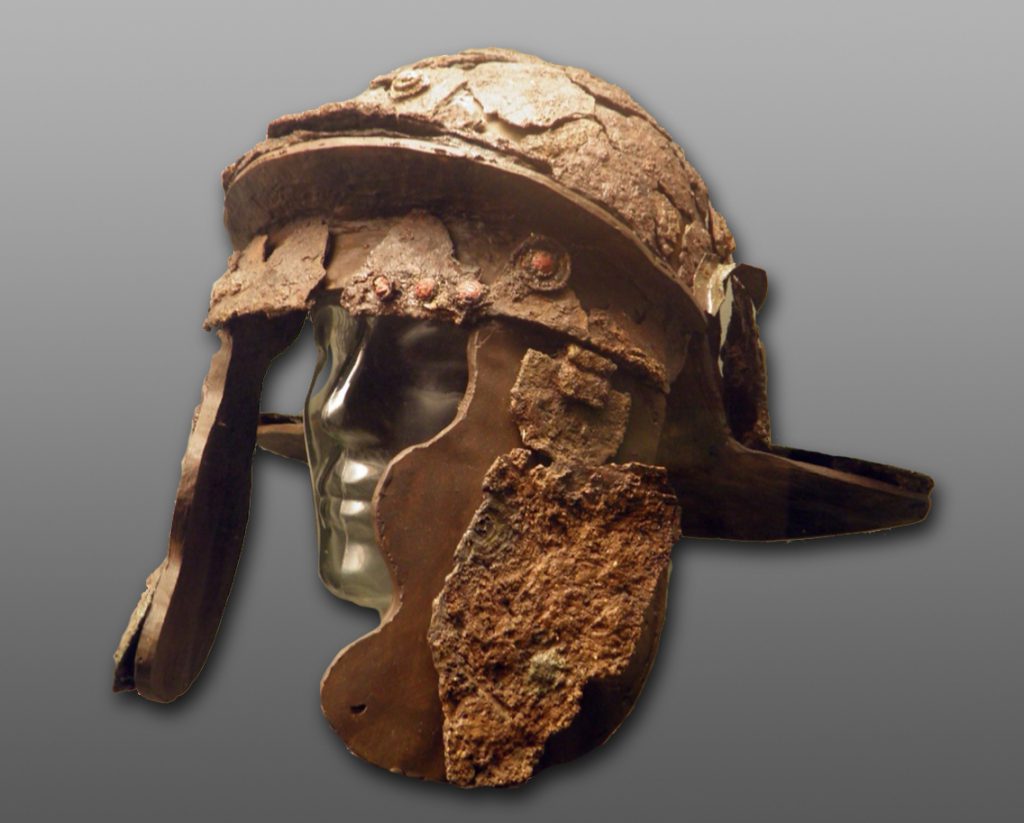
It is interesting to note that these helmets all conform to the same Imperial-Gallic type like those found at Mainz, which were coming into service about the time of the invasion of Britain, and by 6o had become well established.
At the time of the excavation it was suggested that, when Sheepen was destroyed, metal-workers on the site were working in a desperate attempt to rearm the colonists. While an attractive picture, but it is now felt more likely that the military metalwork was scrap, brought to the site sometime after AD 43 for recycling, and that the deposits are not directly connected to the Boudican destruction.
Boudican Destruction Horizon at Colchester
If you were to dig deep into the ground beneath Colchester, you would eventually come to a stratum of reddish-brown ash, peppered with scorched pieces of Roman pottery, which archaeologists call Boudica’s Layer or the Boudican destruction horizon. It ranges in depth from a few centimetres to (exceptionally) as much as one metre. In places the lower parts of buildings are preserved to a height of up to 60 centimetres, allowing the architecture and plan of the legionary fortress and early colonia to be reconstructed in detail. Most of the Boudican destruction horizon is burnt daub. Normally daub does not survive because it reverts to the clay from which it was made, but the high temperatures reached when the town was torched turned it into a more durable substance akin to pottery. Molten glass that had subsequently to the ferocity of the inferno. Broken tiles, wall plaster and smashed pottery are also common.
Boudican destruction horizon is found right across those parts of town and its suburbs that were occupied in AD 60. It is absent from much of the eastern area of the later walled town because those parts of the town destroyed by Boudica, the anticipated burnt layer can be missing where the excavated area lay in gardens behind the houses that fronted the streets. At the west end of town, burnt levels are found outside are of the later town wall, showing urban expansion beyond the former legionary fortress in the years before AD 60. An industrial suburb 750 metres North West of the town at Sheepen was also destroyed in the revolt. Military scrap metal there had been thought to indicate a frantic last minute rearmament drive, but it is now felt that it was simply the raw materials of bronze workers supplying the civilian market of the colonia. An early cemetery just outside the town was also ransacked. Destruction extended into the countryside, to judge by the burnt levels found at the Somerfield site, 1.5 km west of Colchester.
Pottery Evidence
The Boudican destruction horizon is important for archaeology because it provides a fixed point for the chronology for Romano-British pottery and other artefacts. In the case of samian ware, which was traded throughout the Roman world, it is a fixed point of international significance. Some groups of pottery from the Boudican destruction horizon come from warehouses or shops.
At North Hill a building thought to have been a government store had more than thirty identical and unused mortaria bowls with grits on the inside for grinding foodstuffs. Another room and adjacent corridor had over eighty flagons, again all very similar to each other. In the next room there were twenty smashed amphora, most of which had come from southern Spain filled led with olive oil. On the High Street there were two shops that sold samian ware, the famous red-slipped pottery from Gaul. Pottery Shop II was a small timber building; most of its pottery was found close to one wall. Pottery Shop I was at the other end of the High Street.
The samian ware found at Pottery Shop I is older that the Boudican period, which means wither the shop was selling out of date or old samian ware or the shop burned down in an earlier fire c.AD 50-5.
The destruction of the town by fire has preserved remains of foodstuffs that would otherwise in the have decayed and become difficult or impossible archaeological record. Seven sites have produced carbonised gain, the staple food. Most of these caches of grain were dominated by wheat. One of these seven deposits was unusual because about a tenth of it was made up of barley. These Culver Street grains had started to germinate: the sprouts were even, showing the damp responsible was deliberate and not the result of poor storage conditions. This was grain that had been treated to make malt for beer, the earliest example in Britain. Other foodstuffs were more exotic. At Lion Walk there was a deposit of twenty-two dates imported from the Mediterranean world; a single plum was present as well. Another Mediterranean import is represented by the figs from Pottery Shop II. The same shop produced lentils, horsebeans and the spice coriander. Other perishable organic material preserved for study by fire includes burnt timber beams from buildings and a pair of textile mattresses tucked neatly in the corner of a room at Lion Walk.
Other finds from the Boudican destruction horizon shed further light on life in the town in AD 60. The Gilberd School produced a gridiron for cooking. At Sheepen a leaded bronze dice-shaker with two dice was found; left behind in a timber-lined cellar was a leaded gunmetal stamp for embossing leather; elsewhere on the site there was a glass cameo showing a sea nymph. Lamps and moulds for their production were found at the Telephone Exchange site. Mixed up with a few complete artefacts like these are all manner of damaged of incomplete domestic items such as brooches and latch-lifters.
But above all the character of the horizon testifies to the thoroughness with which Colchester had been looted: no gold or silver has been found in the burnt levels, apart from the odd Roman coin. The same story is told by the few hoards of Roman coins present. All three consist of small numbers of relatively low-value copper or brass coins of Claudius and Agrippa (an earlier member of the imperial family). Some of these coins are burnt; the hoards had not been buried in the ground for safety but represent instead purses lying above ground when the town was sacked. Intact material that could be reused was rescued by the Romans after the revolt and this salvage operation has also affected the composition of the destruction horizon. Tiles with burn marks from AD 60 have been found recycled in the footings of later buildings. Pits were dug into the horizon in the search for valuables; they were immediately refilled with the burnt daub extracted from them. Levelling of the debris as a prelude to rebuilding must also have involved an element of salvage.
One casualty of the revolt was discovered on the Telephone Ex-change site, where the charred and disarticulated remains of an adult lay on a verandah fronting the street. In the industrial suburb to the west of the town at Sheepen, fragments of one or more human skulls were found in Pottery Kiln XXVI and they too may represent victims of the revolt. No other victims of the holocaust have been found at Colchester, or indeed at London or Verulamium. This is remarkable because Tacitus says that seventy thousand perished in the sack of these three towns. The Britons did not take prisoners to be sold as slaves but slaughtered everyone who fell into their hands, regardless age or sex, through crucifixion, hanging, fire and the sword. This was not just gratuitous carnage but the sacrifice of victims to the god of war in time honoured Celtic fashion.
Damaged Tombstones
The most spectacular of all the evidence of the fury of the rebels is in the form of two tombstones of serving soldiers. They belong to an early military cemetery about half a mile along the road which left the west gate of the fortress in a south-westerly direction.
Tombstone of Longinus
RIB 201 - Funerary inscription for Longinus Sdapeze
Longinus Sdapeze son of Matucus, duplicarius from the First Cavalry Regiment of Thracians, from the district of Sardica, aged 40, of 15 years’ service, lies buried here his heirs under his will had this set up.
MATYCI DVPLICARIVS
ALA PRIMA TRACVM PAGO
SARDI ANNO XL AEROR XV
HEREDES EXS TESTAM [...] C
H S E
- Above the niche is a winged sphinx, flanked on either side by a lion; round the body of either lion is twined a snake, whose tail the lion holds beneath one paw. In the niche the cavalryman, who once had a hemispherical helmet, is in scale-armour, with oval shield on left arm, and is riding to the right on a richly caparisoned horse, beneath whose belly crouches a naked barbarian with his left hand holding his shield under him. In the right hand of the cavalryman there is a dowel-hole, presumably once filled by a metal weapon.
- Sardi(ca), or more usually Serdica, in Thrace (now Sofia).
- A duplicarius, duplarius or duplaris was soldier receiving twice the basic rate of pay, in particular the second-in-command of a turma
- Sdapezematygus may not be a Thracian name.
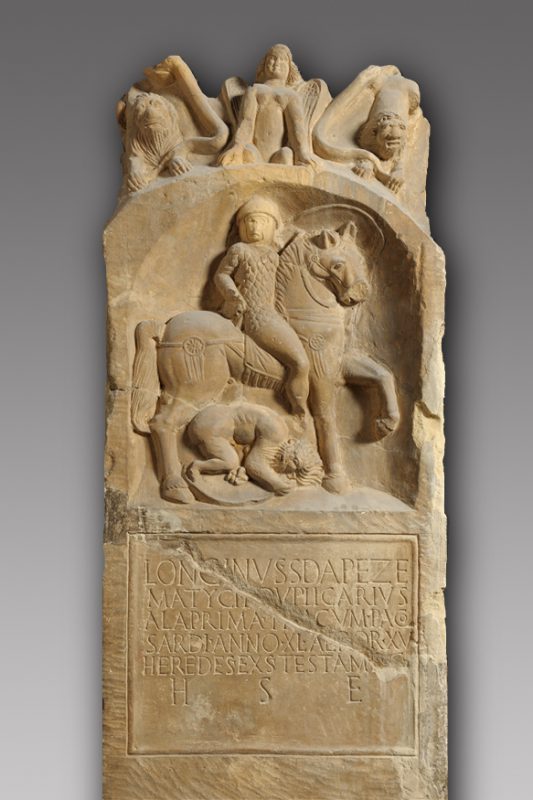
The above of them is a memorial to an officer called Longinus from the Ala Primae Thracum – The first Wing of Thracians. The sculpture on the tombstone shows a mounted cavalryman; below the horse crouches a naked and defeated Briton on his shield. When it was recovered, the tombstone had been smashed into six main pieces and lay face down in the ground. For some time it was thought that the damage was caused by Boudican rebels, however the current thinking is that it was caused when workmen found it.
Tombstone of Marcus Favonius Facilis
RIB 200 - Funerary inscription for Marcus Favonius Facilis
Marcus Favonius Facilis, son of Marcus, of the Pollian voting-tribe, centurion of the Twentieth Legion, lies buried here Verecundus and Novicius, his freedmen, set this up.
LIS 𐆛 LEG XX VERECVND
VS ET NOVICIVS LIB POSV
ERVNT H S E
On the back: tvl in lettering which tapers and is not square-ended. This may be a mark of identification cut at the quarry.The absence of d · m·, the use of the nominative for the names of the deceased, the formula h · s · e, and the absence of Valeria Victrix from leg. XX serve to date the inscription to the first century. The sculpture is hardly weathered; it is probable that it was overthrown in the rising of Boudicca in A.D. 60-61.
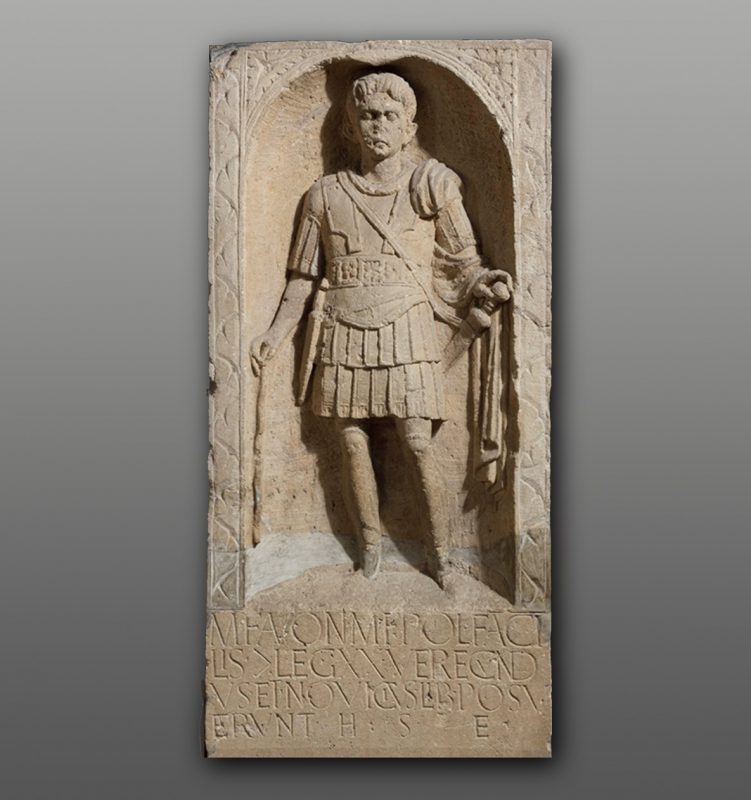
Another tombstone found nearby had broken into two pieces and buried face down in the soil. We know it was near its original position as only three feet away was found a lead cylinder containing the burnt bones (presumably) of Facilis, a small phial (doubtless for a perfume to be poured into the grave), and a
small thin walled cup with a green lead glaze from a factory in the Allier Valley of Central Gaul. The tombstone commemorated an officer in Legion XX, the centurion M. Favonius Facilis. There is no trace of weathering on the tomb and therefore had not been exposed to the elements for long before being toppled over.
On the upper half of the Bath stone is a finely executed relief showing the rather grim-faced centurion, his left hand on the pommel of his sword swinging elegantly at his left side, whilst in his right hand is the vine stick (vituus), the symbol of his office.
Bronze head of the emperor Claudius
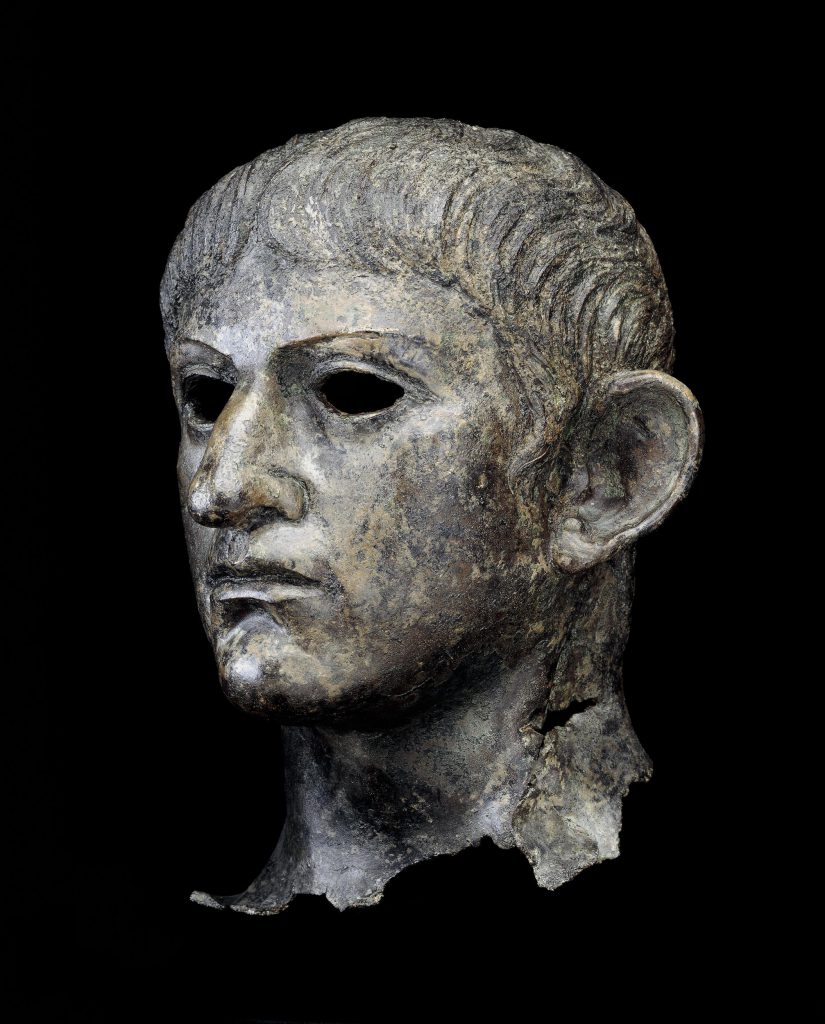
What may have been loot from the town has been found in East Anglia. The most famous piece is a bronze head of the emperor Claudius from the river Alde at Rendham, Suffolk.
A jagged line around the neck showed where it had been wrenched from the body. This was probably as an offering – perhaps inspired by Druids – to the local deity represented by the river. It is worth remembering that water was viewed as an entrance to the Underworld, and was especially connected with Druidic ritual.
The slight backward tilt of the head suggests the original statue had shown the emperor mounted on horseback; we are dealing with an equestrian statue that was on public view in the town. Part of the same statue was found at Ashill, Norfolk, 60 kilometres away. The Ashill fragment is the knee of the horse, hollow-cast like the head of Claudius. What links the two fragments is their alloy, because both pieces have low lead levels. In antiquity lead was usually added to bronze to make it flow more easily when it was cast. Alloys like that represented by the Rendham and Ashill fragments were rare and this suggests that they had indeed come from the same statue.
Continue reading about Boudica’s Revolt and the sack of London